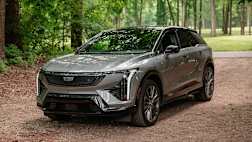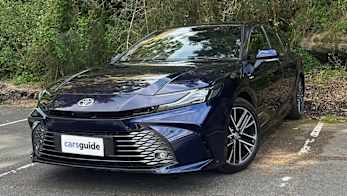Dealer demonstrators sound a bit like unicorns - new cars with just the tiniest number of kilometres on them, barely driven in, immaculately detailed and fussed over.
Cars that are as good as new, then, and bought from a dealer, so you have that peace of mind and yet, and here's the shiny golden horn of the deal, much, much cheaper than an actual brand-new car.
The fact that they sound almost too good to be true suggests a unicorn-like rarity, but the fact is that there are plenty of dealer-demonstrators out there, and if you know when to go looking for one, what to ask for, and what to pay, the dealer demonstrator might be just the new-car bargain you're looking for.
And, of course, as always when buying from dealers, you'll want to make sure you're not paying too much.
What is a dealer demonstrator?
We should probably ask "what is a demo car", because this is Australia, and we prefer to say it that way,right, Dave-oh?
The term demonstrator, or demo car, or even "dealer used" - meaning used by a dealer, rather than a used car - applies to a few different kinds of near-new cars, available for sale at a car dealer.
Usually it refers to the vehicles that are used by the staff at the dealer, usually to take keen punters for test drives - or demonstrations of what the vehicle can do, if you like - and occasionally for their own use.
Dealers often encourage their showroom staff to actually drive the new cars they're selling around a bit, so that they actually know what they're talking about when talking them up.
These cars will usually have very few kilometres on the odometer because the dealer is keen to still be able to sell the while they're looking, both in the metal and on paper, like new cars.
In most states, a car is no longer regarded as a demonstrator once it has more than 5000km on the odometer, which is another incentive for dealers — more than this and it is regarded as a used car.
When buying a demo car you may also come across some vehicles that have very few kilometres on them indeed, perhaps fewer than 50km, because they are more showroom demonstrators - cars that have barely moved but have spent time on the dealer floor, having their tyres kicked and their seats sat in now and then.
These are very-new cars indeed and a great buy if you can snaffle one, at a good price.
Dealers have also increased the definition of "demonstrator" to vehicles that have done no kilometres at all, and aren't even registered.
As manufacturers chase sales targets, they can become quite desperate to increase monthly, quarterly and end of year bonuses to dealers. In some cases the cash incentives are offered in the final days of the month, which is why this is a great time to go car shopping (and the EOFY weeks are the best of all).
To get an extra, say, $2000 off a $30,000 car, the dealer must agree to take a large allocation of vehicles and declare them as sold — even if there aren't any customers who've bought them.
These are known as "called" cars, because the manufacturer can declare them as sold to the Federal Chamber of Automotive Industries, which issues monthly sales data.
Dealers increasingly refer to these vehicles as "demo models" or "undriven demonstrators", which sounds just slightly like a contradiction in terms.
On conservative estimates, at least 10 per cent of cars reported as sold in a given month are still sitting in dealer stock, brand new.
Why will dealers sell you a demo for less?
Generally it is part of a dealer's contract with the manufacturer that they will run a minimum fleet of registered demo cars, with a selection of the most popular models that punters might want to test drive.
The car-maker or importer gives dealers a specific "bonus" or contribution to run each demo, usually $350-$1500 on cars priced between $15,000 and $50,000. A hatchback priced at $20,000-$25,000 usually has a demo bonus of $600 to $750, although these figures vary.
As such, the dealer is in a good position to be able to sell you these near-new cars at a more competitive price than a freshly wrapped example from out the back. One other bonus being that you can choose exactly the car that you're going to buy, and drive it away on the day.
How much of a discount you'll get is a hard question to answer but you should be sure to ask plenty of questions to establish exactly what you're buying, then compare the prices at several dealerships to make sure you're getting a good deal.
Just because a car has a big red "Demo" sticker on it doesn't automatically equate to a bargain and you still need to be wary.
Be sure to check the registration date and the year model of the vehicle, to make sure what you're getting is a really near-new car, at a good price.
When is the best time to buy a demo car?
The maths is fairly simple. When a brand new model, like say the new Mazda 3, launches, you know that dealer-demos will start their working lives. The best time to swoop is two to three months later, when the car is nearing the end of its run.
Most dealers keep a car for at least 45 days to secure the demo bonus but they want to clear it within 60 days or so, to ensure it's still sold with plenty of registration and warranty coverage.
Because dealers want to "flip" demo models regularly, there are almost always some in stock, but if you know the kind of new car you're looking for, just have a look at a calendar and choose the right time to strike.
Should I buy a demo car?
The fact is, a good demo car, particularly a completely unproven one, should be an absolute bargain. Some people are so totally attached to the idea of buying a totally new car that they won't want to feel like they're getting a vehicle that no one has touched by them.
More pragmatic folks will realise that buying a demo model makes a lot of sense, as you're getting a very low-mileage example of the car you want at a bargain price, and the only previous owner is the dealer.
The important questions to ask
Before you buy a demonstrator, ask the dealer when it was registered and when the factory warranty started. If it is unregistered, make sure the new-car warranty starts from the day you take delivery, on its first day of registration.
What types of demonstrators are there?
- The genuine item is a near-new car used by dealer staff for customer test drives. The warranty started when the car was registered and can't be changed.
- Undriven but registered. In most cases the manufacturer has added a bonus and insisted the dealer register the car and declare it as sold, even if it sits in dealer stock. The warranty started when the car was registered and can't be changed.
- Undriven and unregistered. These are becoming more common as manufacturers pump cars into the network and can be good buying. Insist the warranty starts when you pick it up. If the dealer resists, go somewhere else.





.jpg)
.jpg)

.jpg)
.jpg)








.jpg)



.jpg)



